| Textbook | NCERT |
| Board | CBSE Board, UP board, JAC board, HBSE Board, Bihar Board, PSEB board, RBSE Board, UBSE Board |
| Class | 12th Class |
| Subject | History |
| Chapter | Theme one |
| Chapter Name | BRICKS, BEADS AND BONES |
| Topic | NCERT Notes for Class 12 History Chapter 1 bricks BEADS AND BONES |
| Medium | English |
| Especially Designed Notes for | CBSE, ICSE, IAS, NET, NRA, UPSC, SSC, NDA, All Govt. Exam |
NCERT Notes for Class 12 History Chapter 1 BRICKS BEADS AND BONES, (history) exam are Students are taught thru NCERT books in some of the state board and CBSE Schools and class.
As the chapter involves an end, there is an exercise provided to assist students to prepare for evaluation. Students need to clear up those exercises very well because the questions inside the very last asked from those.
Class 12 History Notes Of Chapter 1 BRICKS BEADS AND BONES is full of mystery and lots of interesting facts that would wander your mind. After studying this class 12 history notes bricks beads and bones, you will ask your mind how this flourishing civilization ended. In the present 21st century, we cannot read or understand the Harappan language, which forms of language communication Harappan people used.
NCERT Class 12 History Revision Notes PDF
This chapter, class 12 history notes bricks beads and bones Pdf, will give you an idea of how Harappan people live in Harappan cities by understanding the town’s structure and the technology they use for farming.
Class 12 history pdf notes have been made by our experience teacher who is working with our organization; our motive is to provide the best notes for our students and help them acquire knowledge about Harappan. Notes are suitable for all class 12 history boards in CBSE format, upboard, etc. Notes are available in English, but soon they will be available in Hindi. Also, the story connects with us.
NCERT Class 12 Notes Bricks beads and bones Chapter 1 Pdf
NCERT Notes for Class 12 History Chapter 1 Bricks BEADS AND BONES
Class 12 History THE HARAPPAN CIVILIZATION
Indus valley civilization is also known as the Harappan civilization.
- It flourished along River Indus (now in Pakistan) around 2600 B.C.
- Harappan civilization was the most significant Bronze age civilization in the world
- Harappa was the first site of this civilization discovered by archaeologists
- It was an urban civilization. Its writing is not deciphered
- After 1900 B.C., most of the sites were abandoned due to some reasons
- By 1900 B.C. major part of the civilization ended
Class 12 Period of Harappan Civilization
- The civilization is dated between 2600 BCE and 1900 BCE
The period of the civilization is broadly divided into three parts:
- The Early Harappan culture (Before 2600 BCE)
- The Mature Harappan culture (2600 BCE to 1900 BCE)
- The Late Harappan culture (After 1900)

Class 12 Important Sites Of The Harappan civilization
Kalibangan, Lothal, Rakhigarhi, Dholavira, Rupar, Harappa, Ganeriwala, Chanhudaro, Sutakagendor, Mohenjodaro, Amri, Balakot, Kot Diji, Rangpur, Nageshwar, Ganeriwala etc.

Class 12 Significant Developments in Harappan Archaeology
- 1875-Report of Alexander Cunningham on Harappan seal
- 1924-John Marshall announced the discovery of Harappan civilization
- 1925-Excavation began at Mohenjodaro
- 1944-R E M Wheeler became the Director General of ASI
- 1946- R E M Wheeler excavates at Harappa
- 1955-S.R.Rao begins excavation at Lothal
- 1960–B.B Lal&B.K Thaper begins excavations at Kalibangan
- 1974-M.R.Mughal begins explorations in Bahawalpur
- 1990-R.S Bisht begins excavations at Dholavira.
BEGINNINGS (Early archaeological cultures)
There were several archaeological cultures in the region before the Mature Harappan.
- These cultures were associated with distinctive pottery, evidence of agriculture, pastoralism, and some crafts.
- The settlements were small in size and had no large buildings.
Subsistence strategies
Subsistence strategies of the people included hunting and gathering, cultivation, pastoralism, and distribution.
- There is evidence of bones of animals which proves that people consumed meat. Terracotta models of oxen and ploughs show that people relied on agriculture too.
(Agriculture) Different types of food available to the people
The Harappans ate many plants and animal products, including fish.
- Archaeologists found grains such as wheat, barley, lentils, chickpea, and sesame at Harappan sites.
- In Gujarat, Millets have been found. Rice was found rarely.
Bones of cattle, fish, fowl, sheep, goat, buffalo, pig, boar, deer, and gharial are found at the sites. Studies indicate that these animals were either domesticated or hunted by the Harappans.
Agricultural technologies of Harappans
Agriculture was the main occupation of the Harappans.
- Finds of grains indicate the prevalence of agriculture.
It is complicated to reconstruct actual agricultural practices carried out by the Harappans.
- Terracotta sculptors of the bull and their representation on the seals indicate that bull was known to them.
- From this, the archaeologists assume that the oxen were used for ploughing.
Terracotta models of the plough
Moreover, Archaeologists have also found terracotta models of the plough at sites in Cholistan and Banwali (Haryana).
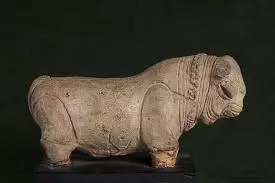
- Evidence of a ploughed field has also been found at Kalibangan(Rajasthan), associated with early Harappan levels.
- The field had two sets of furrows at right angles to each other, suggesting that two different crops were grown together.
Harappan irrigation system
Most of Harappan sites were located in semi-arid regions. So, to enhance agricultural production, they needed facilities for irrigation.

- Traces of canals have been found at the Harappan site of Shortughai in Afghanistan.
- It is also likely that water drawn from wells was used for irrigation.
- Besides, water reservoirs in Dholavira (Gujarat) may have been used to store water for agriculture.
Layout of Mohenjodaro: Architectural features of Mohenjodaro| MOHENJODARO A PLANNED URBAN CENTRE

- The most spectacular part of the Harappan structure is the large-scale town layout.
- The city of Mohenjodaro was divided into two sections i.e.the Citadel(Smaller but higher) and the lower city(much larger but lower).
The Citadel
The citadel was walled, which meant it was separated from the lower town.
- The buildings were constructed on mud-brick platforms.
- There were variations in Harappan settlements.
At sites such as Dholavira and Lothal (Gujarat), the entire settlement was fortified, and walls also separated sections within the town.
- The citadel within Lothal was not walled off but was built at a height.
The Great Bath
The Great Bath was a large rectangular tank in a courtyard surrounded by a corridor on all four sides.
- There were two flights of steps on the North and the South to reach the tank.
There are structures in the citadel that were probably used for special public purposes.
- These included the warehouse and the Great Bath.
The Great Bath was made watertight by setting bricks on their edges and using the plaster of gypsum.
- There were rooms on three sides of it, one of which was a large well.
- Water from the tank flowed into a huge drain.

On the North side, there was a smaller building having eight bathrooms, four on each side of its corridor.
- From each bathroom, drains were coming out, connected to a drain that ran along the corridor.
- Seeing the uniqueness of the structure, scholars suggest that it was meant for a special ritual bath.
The Lower Town
The lower town was organised on a grid system which served as foundations. It was also walled.
- Archaeologists believe that it was probably the city where most of the people lived and worked.
- Bricks used for settlements were sun-dried or baked.
- They were of standardised ratio, where the length and breadth were four times and twice the height respectively.
Laying out drains
One of the most distinctive features of Harappan cities was the carefully planned drainage system.
- Roads and streets were laid out along an approximate “grid” pattern, intersecting at right angles.
- Street with drains was laid out first, and then houses were built along them.
- If domestic wastewater had to flow into the street drains, every home needed at least one wall along a street.
The drains were made of mortar, lime, and gypsum.
- They were covered with big bricks which could be lifted easily to clean the drains.
- Very long drainage channels were provided at intervals with sumps for cleaning.
- Little heaps of materials mostly sand have frequently been found alongside the drains.
- This shows that the drains were cleaned at regular intervals.
Domestic Architecture
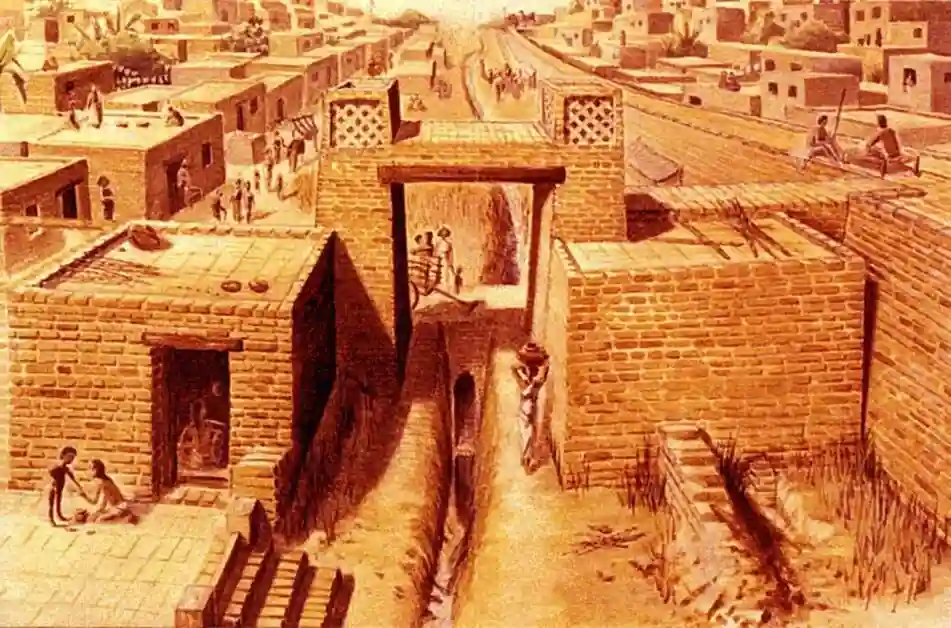
Most of the residential buildings were centered on a courtyard with rooms on all sides.
- The courtyard was the center of activities such as cooking and weaving.
- There were no windows in the walls along the ground level.
- The main entrance does not give a direct view of the interior of the courtyard.
Every house had its bathroom with drains connected through the walls to the street drains.
- Some houses have remains of staircases to reach a second story or the roof.
- Many houses had wells, often in a room that could be reached from outside and used by passers-by.
- The total number of wells in Mohenjodaro was about 700.
Tracking Social Differences: Strategies to find out social differences
1. Studying Burials
Strategies to analyze social and economic differences among people living within a particular culture include the study of burials.
- At burials in Harappan sites, the dead were generally laid in pits.
- Some of the pits were lined with bricks.
- Some of the burials contained ornaments, pottery, etc., maybe a belief that these things can be used afterlife.
- The jewelry was found in both men’s and women’s burials, meaning that both men and women used ornaments.
- In some instances, the dead were buried with copper mirrors.
But Harappans never believed in burying precious things with the dead.
2.Studying Artefacts
- Studying artefacts is another strategy to find out social differences.
- Artefacts are divided into utilitarian and luxuries.
Utilitarian artefacts include objects made of stone or clay.
- These include querns, pottery, needles, flesh rubbers, etc. and are usually distributed throughout settlements.
Luxury artefacts are rare objects made of valuable materials generally concentrated in large settlements like Mohenjodaro and Harappa.
- For Example, little pots of faience were used as perfume bottles and are found mainly in Mohenjodaro and Harappa.
Finding out about craft production
Chanhudaro is a small town that was famous for craft production.
- This city was busy with craft production like bead-making, shell-cutting, metalworking, seal-making and weight-making.
- The materials used in making all these crafts were stones like carnelian (of a beautiful red colour), jasper, crystal, quartz and steatite; metals like copper, bronze, and gold; and shell, faience and terracotta or burnt clay.

Methods of making crafts
- The Harappans Sometimes made beads made of two or more stones by cementing them together, while some stones with gold caps.
- They were made in different shapes, such as cylindrical, spherical, barrel-shaped, and segmented.
- Some were decorated with paintings, and some had designs etched on them.
- They made bangles and ladles out of shells.
- Special tools were used for craftwork.
Centre of crafts production
- Specialized drills have been found at Chanhudaro, Lothal and Dholavira.
- Nageshwar and Balakot were specialized centres for making shell objects, including bangles, ladles and inlay.
- Chanhudaro was the centre of crafts production. It was a specialist in bead-making, shell-cutting, metalworking, seal-making and weight-making.
They obtained different materials from different cities which were as follows:
| Material | Cities |
| Shell | Nageshwar, Balakot |
| Blue stone(Lapis Lazuli) | Shortughai (Afghanistan) |
| Carnelian (a glossy stone) | Bharuch in Gujarat |
| Steatite | South Rajasthan and North Gujarat |
| Metal | Rajasthan |
| Copper | Khetri (Rajasthan). Archaeologists named the Khetri area as Ganeshwar-Jodhpura culture |
| Gold | South India |
Identifying centres of production.
How centers of production were identified by the archaeologists?
- Simply by evidence of tools, raw materials, unfinished objects, rejects, waste materials, etc.
Strategies for procuring materials for craft production
Some craft production materials were locally available, and some were transported outside the alluvial plain.
Terracotta models of bullock carts are found. So This suggests that the bullock cart was one of the essential means of transport at that time.
Riverine routes were also probably used. For procuring raw materials, expeditions were sent to other areas.
Material from the subcontinent and beyond
The Harappans procured materials for craft production in various ways.
Two methods of procuring materials for craft production
- They established settlements in Nageshwar, Balakot, and Shortughai.
- They might have sent expeditions to areas such as the khetri region of Rajasthan (for copper) and south India (for gold).
Contact with distant lands (Trade relation with the world)
Archaeological finds suggest that the Harappans maintained long-distance trade.
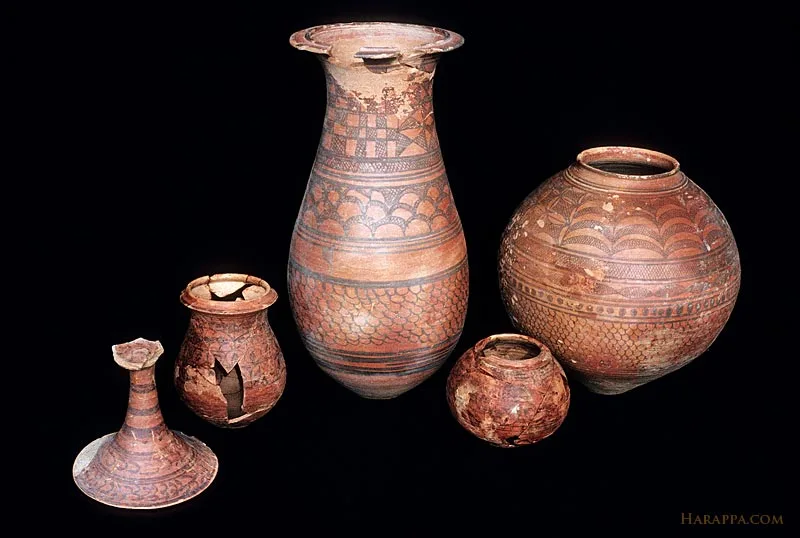
- The primary source of long-distance contact includes seals, weights, dice, and beads.
- Harappans probably had trade contacts with the Oman peninsula.
- Chemical analyses have shown that both the Omani copper and Harappan artifacts have nickel traces, suggesting a common origin.
- A Harappan jar coated with a thick layer of black clay has been found in Oman.
- The Harappan may have exchanged the contents of these vessels for Omani copper.
- Some data shows that Mesopotamia transported the copper from Magan, Oman.
- Mesopotamian texts refer to contact with regions named Dilmun (probably the island of Bahrain), Magan and Meluhaha, possibly the Harappan.
Evidence of depiction of ships and boats on seals.
Seals, Script, Weights
Seals and Sealings
Seals and Sealings were used to facilitate long-distance communication.
- When a bag of goods was sent from one place to another, its mouth was tied with a rope.
- On the knot was affixed some wet clay on which one or more seals were pressed, leaving an impression.
- If the bag reached with its sealing intact, it had not been tampered with.
- The sealing established the identity of the sender.
- The Harappan seal is the most distinctive artefact; the seal is made of a stone called steatite.
- The seals also contain animal motifs and signs from a script.
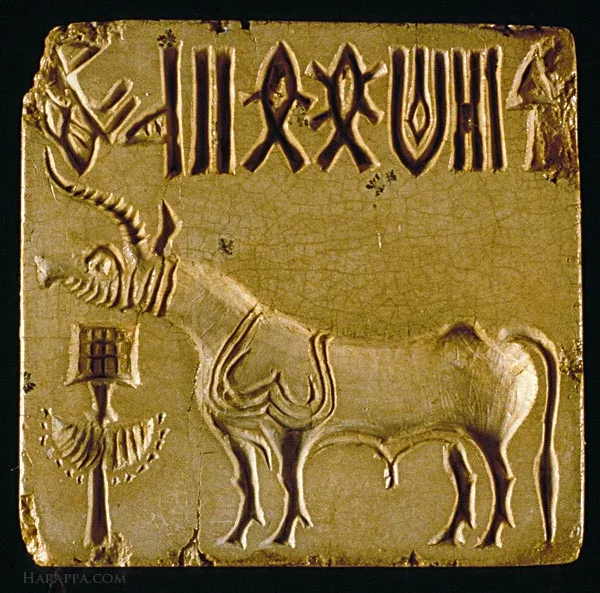
A cylinder seal found in Mesopotamia has a humped bull motif, which can be derived from the Indus region.
The round Persian gulf seal found in Bahrain sometimes carries Harappan motifs.
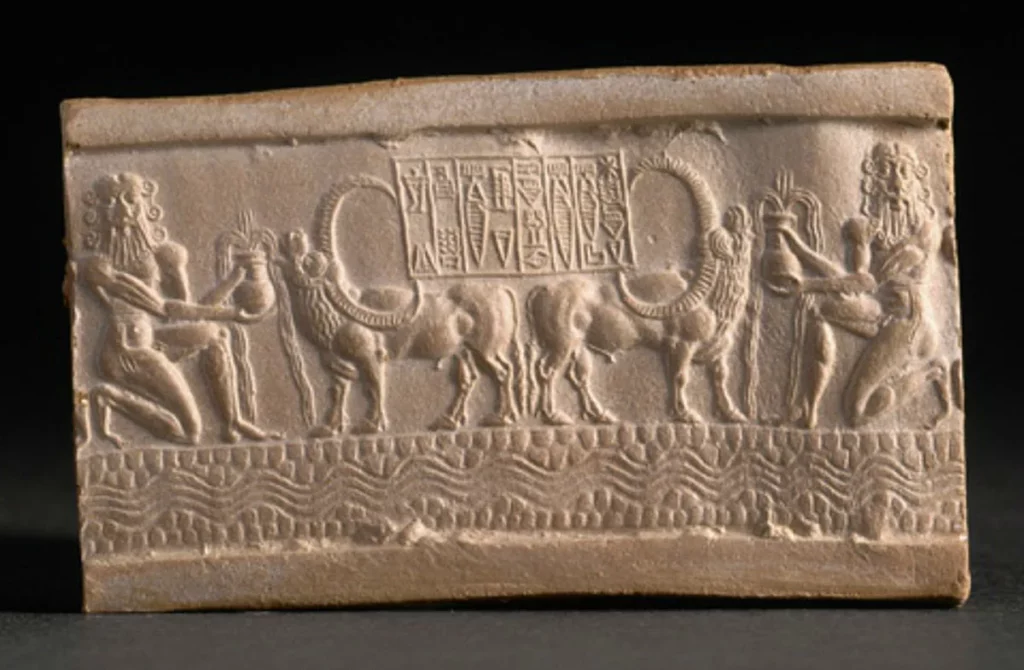
An enigmatic script (Characteristics of Seals and Script)
- Harappan seals usually have a line of writing.
- The seal had the name and title of the owner.
- The seal had a motif (generally an animal) that conveyed a meaning to those who could not read.
- Seals were basically used to convey the identity of the sender and to facilitate long-distance communication.
- The Harappan inscriptions are short, the longest containing about 26 signs.
- The script was not alphabetical and written right to left.
- Many signs were used and they are around 375-400 in number.
- Mostly scripts are still remains undeciphered to the date.
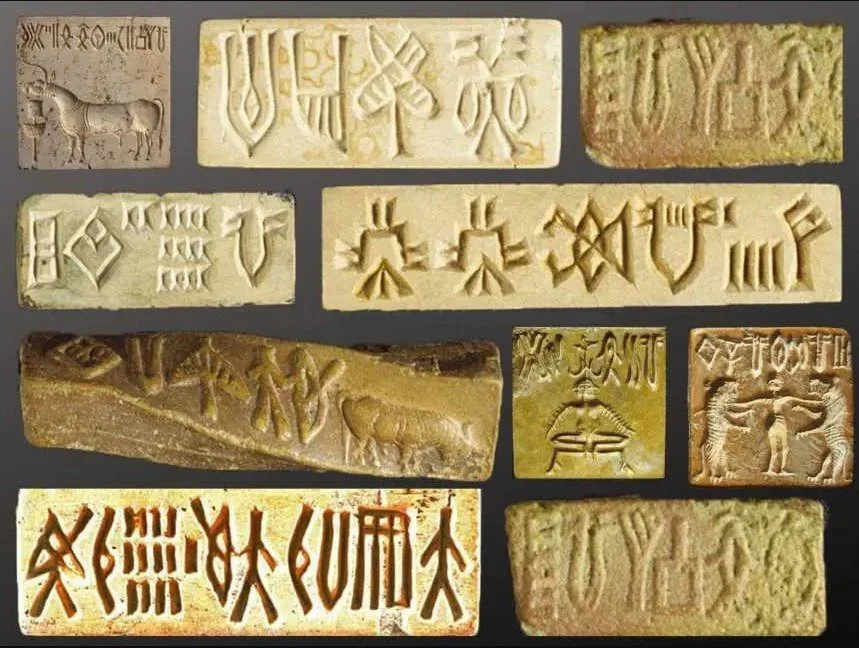
Writing has been found on seals, copper tools, rims of jars, bone rods, copper and terracotta tablets and jewellery bone rods and an ancient signboard.
Weights

- Exchangers were regulated by a precise system of weights usually made of a stone called chert (a kind of stone, generally cubical with no markings).
- Lower denominations of weights were binary (1, 2,4,8,16,32, etc.), while the higher denominations followed the decimal system.
Governance in Harappan culture
The archaeologists put forward different arguments over the central authority of Harappa.
The Extraordinary uniformity of Harappan artefacts is evident in pottery, seals, weights, and bricks, suggesting some forms of authority and governance.
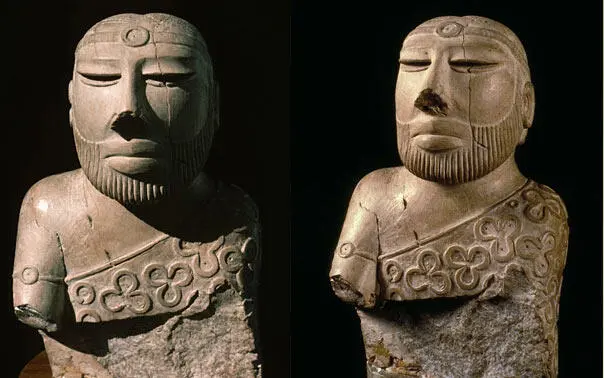
There are three major views about the existence of a central authority in Harappan society.
- Some archaeologists believe that there were no rulers in the Harappan society and that everybody enjoyed equal status.
- Others believe that there was no single ruler but several rulers. Monenjodaro had a separate ruler, Harappa had a separate, and so on.
- Yet others argue that there was a single state. This theory was based on the similarity of artefacts, planned settlements, etc.
- The last opinion is more plausible as it is doubtful that such complex decisions were made and implemented collectively by entire communities.
The End of the Civilization
The Evidence that reflected the disappearance of the Harappan civilization by 1800 BCE
By 1800 BCE, most of the mature Harappan sites were abandoned.
- The expansion of population and its migration took place towards Gujarat, Haryana, Western U.P, etc.
After 1900B.C.E sites which existed marked the transformation of material culture, i.e., the disappearance of distinctive artefacts of civilization like weights, seals, foreign trade, etc.
- Writing, long-distance trade, and craft specialization also disappeared.
- House construction techniques deteriorated, and large public structures were no longer produced.
- So, This indicates a rural way of life named late Harappan or successor cultures.
Several explanations for the decline of the Harappan civilization
The reasons responsible for the end of civilization are still unknown. But probable reasons are;
- Climatic Change
- Deforestation
- Excessive floods
- Overuse of the landscape
- The shifting and or drying up of rivers
- Invasion, most probably by the Aryans
- The Harappan state came to an end. There is Evidence of the absence of specific art facts like seals, pottery, etc.
Discovering the Harappan Civilization
The discoveries of the Harappan Civilisation by archaeologists were as follows :
Cunningham and his Confusions
Cunningham was the first Director General of ASI (Archaeological Survey of India).
- He was known as the father of Indian archaeology.
- He began archaeological excavations in the mid-19th century.
Evidence used by Cunningham
His primary interest was in the archaeology of early history from 6th-century BCE- 4th century CE and later periods.
- He used the accounts left by Chinese pilgrims who had visited the subcontinent between the 4th and 7th centuries CE.
- He also collected, documented, and translated inscriptions found during his Excavations.
- Sites like Harappa did not fit well in his area of investigation.
Alexander Cunningham Confusion
Although Harappan artefacts were found during the 19th century, some reached Cunningham.
- But he did not realize how old these were as they were not part of the itinerary of Chinese pilgrims and were not known as Early Historic cities.
- An English man gave a Harappan seal to Cunningham.
- But he could not place it in the time frame with which he was familiar. He thought that Indian history began with the first cities in the Ganga valley.
- So, it is assumed that he missed the significance of Harappa.
Marshall and Wheeler adopted different methods in reconstructing the Harappan civilization.
Daya Ram Sahni
In the early decades of the 20th century, seals were discovered at Harappa by Daya Ram Sahni.
Rakhal das Banerji
He also found similar seals at Mohenjodaro, leading to conjecture that these sites were part f a single archaeological culture.
John Marshall
Based on the finding of Daya Ram Sahni and Rakhal das Banerji found in 1924, John Marshall was the Director General of the ASI.
- In 1924 he announced the discovery of a new civilization in the Indus valley to the world.
- Marshall tended to excavate along regular horizontal units, measured uniformly throughout the mound, ignoring the site’s stratigraphy.
- The artefacts recovered from the same unit were grouped, even if found at different stratigraphic layers.
As a result, valuable information about the context of these finds was irretrievably lost.
R.E.M Wheeler
He was the Director General of the ASI in 1944.
- He recognized that it was necessary to follow the stratigraphy of the mound rather than dig mechanically along uniform horizontal lines.
- R.E.M. Wheeler rectified this problem.
Problems of piecing together the past
Problems faced by archaeologists in the interpretation of religious practices of Harappa.
- The Harappan script does not help understand the Harappan civilization. The script remains undeciphered to date.
- Material remains to help the archaeologists to reconstruct Harappan’s life.
Organic materials such as cloth, leather, wood, and reeds generally decompose, while stone, burnt clay, metal, etc., survive.
Materials such as pottery, tools, ornaments, and household objects are available.
Classifying finds (Division Of Finds Have Survived)
Recovering artefacts is just the beginning of the archaeological enterprise. Archaeologists then classify their findings.
- One simple principle of classification is in terms of materials such as stones, clay, metal, bone, ivory, etc.
- The second and most complicated, archaeologists have to decide whether, for instance, an artifact is a tool or an ornament, or both, or something meant for ritual use.
- An understanding of the function of an artefact is often shaped by its resemblance with present-day things-beads; querns, stone blades, and pots are prominent examples.
Archaeologists also try to identify the function of an artefact by investigating the context in which it was found, whether it was found in a house, drain, grave, or kiln.
Problems of interpretation
- The problems of archaeological interpretation are perhaps most evident in attempts to reconstruct religious practices.
Attempts have also been made to reconstruct religious beliefs and practices by examining seals, some of which seem to depict ritual scenes.
- Others, with plant motifs, are thought to indicate nature worship.
Many reconstructions of the Harappan religion are made on the assumption that later traditions provide parallels with earlier ones.
- This is because archaeologists often move from the known to the unknown, from the present to the past.
Archaeologists attempt to reconstruct the religious practices of Harappan people.
The discovery of pots, querns, beads, etc., in the Harappan sites and their graves provide enormous information.
- Traces of cotton and dresses depicted on seals and sculptures give us an idea about the dressing style of Harappan people.
- The terracotta figurines of women indicate the worship of the mother goddess.
- Plant motifs suggest the practice of nature worship.
- Some animals, such as the unicorn depicted on seals, seem to be mythical, composite creatures.
In Some seals, a figure shown seated cross-legged in a ‘yogic’ posture, sometimes surrounded by animals, has been regarded as a depiction of proto-Siva.
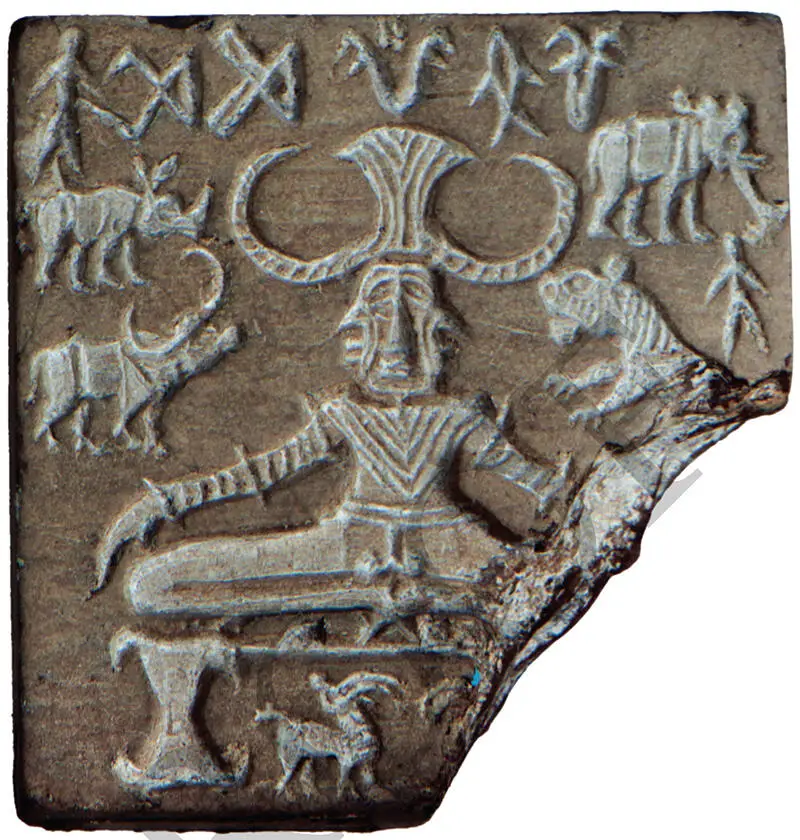
- Which is an early form of one of the major deities of Hinduism.
- The conical stones indicate linga worship.
The two important structures that archaeologists have found are :
- The fire altars found at Kalibangan and Lothal and The Great Bath at Monhenjodaro were meant for ritual use.
Ncert Class 12 history chapter 1 notes: Timeline
Timeline 1
Major periods in Early indian Archaeology
| 2 million BP (BEFORE PRESENT) | Lower Palaeolithic |
| 80,000 | Middle Palaeolithic |
| 35,000 | Upper Palaeolithic |
| 12,000 | Mesolithic |
| 10,000 | Neolithic (early agriculturists and pastoralists) |
| 6,000 | Chalcolithic (first use of copper) |
| 2600 BCE | Harappan civilisation |
| 1000 BCE | Early iron, megalithic burials |
| 600 BCE-400 CE | Early Historic |
Timeline 2
Major Developments in harappan Archaeology
| 1875 | Report of Alexander Cunningham on Harappan seal. |
| 1921 | MS Vats begins excavations at Harappa. |
| 1925 | Excavations begin at Mohenjodaro. |
| 1946 | REM Wheeler excavates at Harappa. |
| 1955 | SR Rao begins excavations at Lothal. |
| 1960 | BB Lal and BK Thapar begin excavations at Kalibangan. |
| 1974 | MR Mughal begins explorations in Bahawalpur. |
| 1980 | A team of German and Italian archaeologists begins surface explorations at Mohenjodaro. |
| 1986 | American team begins excavations at Harappa. |
| 1990 | RS Bisht begins excavations at Dholavira. |
Class 12 history notes chapter 1 bricks beads and bones : Important terms
Hoards: Hoards are objects kept carefully by people, often inside containers such as pots.
Seal: It generally contained animal motifs and signs from a script to identify its user.
Stratigraphy: The study of layers.
Linga: A linga is a polished stone worshipped as a Shiva symbol.
Shamans: Shamans are men and women who claim magical and healing powers and the ability to communicate with the other world.
Steatite: It is a type of stone that is like talc or soapstone.
Saddle querns: Saddle querns were the only means of grinding cereals and pulses. They were made of hard, gritty rock or sandstone. The remains of saddle querns show signs of hard usage.
Curry stones: The type of quern in which the second stone was used as a pounder, which eventually made a cavity in the base stone, was called curry stones. This type was possibly used only for pounding herbs and spices for making curries.
Chert: Chert was a type of stone, generally cubical with no markings. It was used in the system of weight by the people of Harappan people.
Archaeo: Botanists: Specialists in ancient plant remains.
Mound: Reuse of the landscape results in the build-up of occupational debris.
Motif: A Symbol used by the Harappans on seals o mark some sort of trademark.
Evidence of an ‘invasion’-Theories propounded by scholars.
Evidence of an ‘invasion’-Theories propounded by scholars. Harappan civilization Invasion Theories By Scholars
Ncert Class 12 history chapter 1 notes: Summary
Class 12 history notes bricks beads and bones Summary will help you to cover the topic very fast while preparing all chapters of Ncert; our notes are already the best but note summaries help you to cover chapters faster, and class 12 notes help you to gain marks.
NCERT Class 12 history Chapter 1 Revision Notes Bricks beads and bones
Class 12 History revision notes Bricks beads and bones will help you to clear your long Ch in an easy format and help the student to score better in the exam. Bricks, beads, and bones history revision notes will help the student complete the syllabus quickly.
Class 12 History ch 1 Bricks beads and bones history revision notes will provide information about Harappan Civilisation and Excellent town planning of Harappan Civilisation and agricultural techniques that the Harrapan used and governance of Indus valley Civilisation, Bricks beads, and bones. Class 12 history revision notes will also provide about the trade structure of Harappan.
Class 12 History chapter 1 book pdf
To download the pdf of class 12 history Ncert chapter 2,
Class 12 History Chapter 1 ईंटें , मनके तथा अस्थियाँ Bricks, Beads and Bones The Harappan Civilisation Notes in Hindi
Class 12 history chapter 1 notes in hindi is under working, soon it will available for our user stay connect with us.
Class 12 History chapter 1 notes bricks beads and bones: FAQs
Question: What was Cunningham’s confusion class 12 history notes chapter 1 ?
Ans: Although Harappan artefacts were found during the 19th century, some reached Cunningham.
- But he did not realize how old these were as they were not part of the itinerary of Chinese pilgrims and were not known as Early Historic cities.
- An English man gave a Harappan seal to Cunningham.
- But he could not place it in the time frame with which he was familiar. He thought that Indian history began with the first cities in the Ganga valley.
- So, it is assumed that he missed the significance of Harappa.
Question: What strategies adopted to identify Social differences among the Harappans class 12 history notes chapter 1 ?
Ans: Two strategies were adopted to identify Social differences among the Harappans:-
- Studying Burials
Strategies to analyze social and economic differences among people living within a particular culture include the study of burials.
- At burials in Harappan sites, the dead were generally laid in pits.
- Some of the pits were lined with bricks.
- Some of the burials contained ornaments, pottery, etc., maybe a belief that these things can be used afterlife.
- Studying Artefacts
- Studying artefacts is another strategy to find out social differences.
- Artefacts are divided into utilitarian and luxuries.
Question: What is the Period of the Harappan Civilization class 12 history notes chapter 1 ?
Ans: The civilization is dated between 2600 BCE and 1900 BCE
The period of the civilization is broadly divided into three parts:
- The Early Harappan culture (Before 2600 BCE)
- The Mature Harappan culture (2600 BCE to 1900 BCE)
- The Late Harappan culture (After 1900)
Question: What are the important sites of the Harappan civilization class 12 history notes chapter 1 ?
Ans: Kalibangan, Lothal, Rakhigarhi, Dholavira, Rupar, Harappa, Ganeriwala, Chanhudaro, Sutakagendor, Mohenjodaro, Amri, Balakot, Kot Diji, Rangpur, Nageshwar, Ganeriwala etc.
Question: What were the features of the drainage system of Harappan civilization class 12 history notes chapter 1 ?
Ans: One of the most distinctive features of Harappan cities was the carefully planned drainage system.
- Roads and streets were laid out along an approximate “grid” pattern, intersecting at right angles.
- If domestic wastewater had to flow into the street drains, every home needed at least one wall along a street.
- The drains were made of mortar, lime, and gypsum.
- They were covered with big bricks which could be lifted easily to clean the drains.
- Little heaps of materials mostly sand have frequently been found alongside the drains.
- This shows that the drains were cleaned at regular intervals.
Question: What were the reasons for the decline of the Harappa civilization class 12 history notes chapter 1 ?
Ans: The reasons responsible for the end of civilization are still unknown. But probable reasons are;
- Climatic Change
- Deforestation
- Excessive floods
- Overuse of the landscape
- The shifting and or drying up of rivers
- Invasion, most probably by the Aryans
- The Harappan state came to an end. There is Evidence of the absence of specific art facts like seals, pottery, etc.
Class 12 History Notes Important Chapter
Ncert notes for Class 12 history Chapter 2 Notes